The Wrigley Field renovations are a sweeping project, inside and out. Just weeks after winning the job to update one of America’s most storied stadiums, Kelly Holton, Populous senior graphic designer, was surrounded by fans reveling in a World Series Championship. The first for Major League Baseball’s Chicago Cubs in 98 years, Holton walked the streets around Wrigley Field and witnessed fans’ unbridled passion. But what this graphic designer noticed most was the chalk art that fans organically drew on the brick walls of the 1914-opened Wrigley Field.
And to Holton and the experiential branding group, dubbed Activate, within sports architecture firm Populous, the 100 years of history at Wrigley Field afforded plenty of design inspiration. So did the chalk art.
“We were riding that roller coaster and getting excited about the team,” Holton says about the early days of the project. “It was really high energy and a great way to kick off a project.”
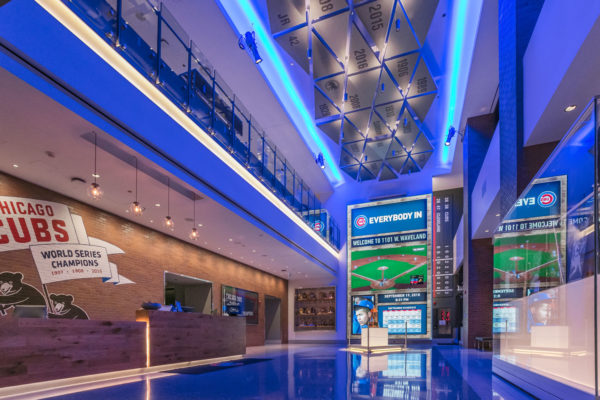
Image courtesy of Populous
Brand New Beginnings
The first part of an assignment that Holton has worked on for over three years included a brand-new office building next to Wrigley Field. It is there she tells the stories of the team’s greatest moments while celebrating the World Series trophy.
The office building was simply the opening of a project, and the Activate team has now touched nearly every aspect of in-stadium design—from wayfinding to premium club spaces. Many of those updates are debuting this April for the start of the 2019 MLB season.
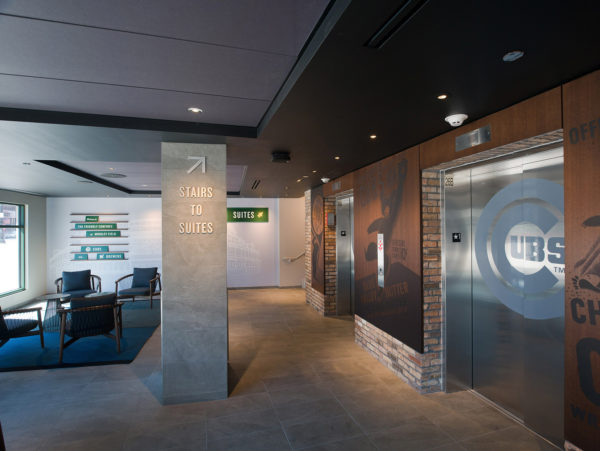
Image courtesy of Populous
The work, though, started in the office building. Populous’ Activate created a different story for each elevator lobby level and integrated branding into conference rooms and meeting spaces. From there, the Activate group turned its attention to the inside of Wrigley Field. With its mix of talent in product design, branding, hospitality and even museum exhibit design (a strength of Holton’s), Populous seized the opportunity to focus on everything from college recruiting spaces, hall of fame locations, premium clubs and general signage.
Wrigley Field Renovations Are Restorations
The Wrigley Field aspect consists of a variety of premium club spaces—with three of those opening this spring—and every sign in the building.
“With a 100-plus-year-old building with no views to the field from the concourse, it is not as easy as other ballparks to know where you are,” Holton says. “Coming up with new ways to help people find their seats and eliminate congestion on a tight concourse required a layer of strategy.” But it also allowed for a new authentic design system.
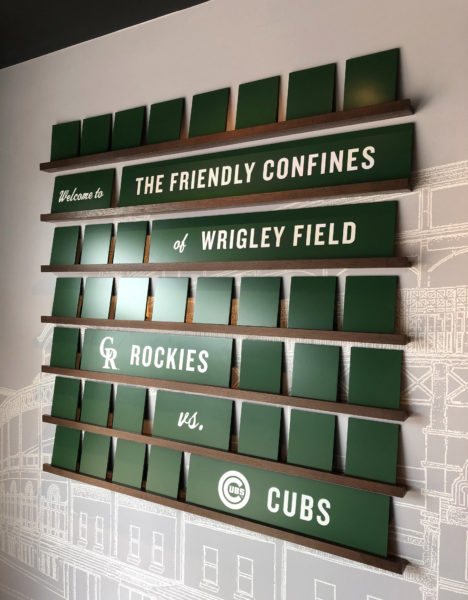
Image courtesy of Populous
“The project as a whole, rather than a renovation, is more of a restoration,” she says. “It is taking Wrigley Field back to the heyday of the 1930s when the scoreboard was originally designed and the marquee was installed.” As the architecture and building façade call to the 1930s, the design team studied vintage types of fonts from the era, inspiring the palette for the entire signage system.
Findings Ways and Keeping Score
Paying tribute to the mechanical, hand-operated scoreboard and tiles, wayfinding has subtle framing details as a nod to the scoreboard itself and two tones of green. The font mixture was intended to “strike the right tone of vintage type,” mimicking the look of the old method of sign painting or paint on glass windows of a restaurant in the 1930s.
The condensed san serif font mixes with script to create a “friendly” design that fits in the Friendly Confines, the moniker of Wrigley Field. “We are striking that balance of vintage and friendly in a natural way,” Holton says. “That was our goal.”
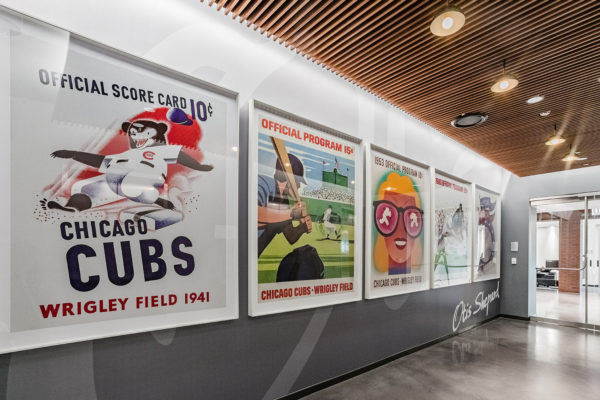
Image courtesy of Populous
The Cubs also once used Wrigley’s chewing gum artist Otis Shepard to create artistic scorecards for the team. Many of those scorecards lived in the team’s archives, so Holton mined them to create painted murals throughout the ballpark that mimic that style or take direct reference. “It is all honoring the past, which is what makes Wrigley Field such a great destination,” she says. “We are making that experience have a strong presence through every detail.”
Join the Club
The Wrigley Field renovations project was much more than stadium signage, as the premium space upgrades require a fresh approach for each club, depending on the theme and sponsor. For example, last year the Cubs opened the 1914 Club in honor of the year Wrigley Field opened. With American Airlines as the sponsor, the club space exudes vintage, from Wrigley Field history to posters from American Airlines’ company archives advertising flights to Chicago.
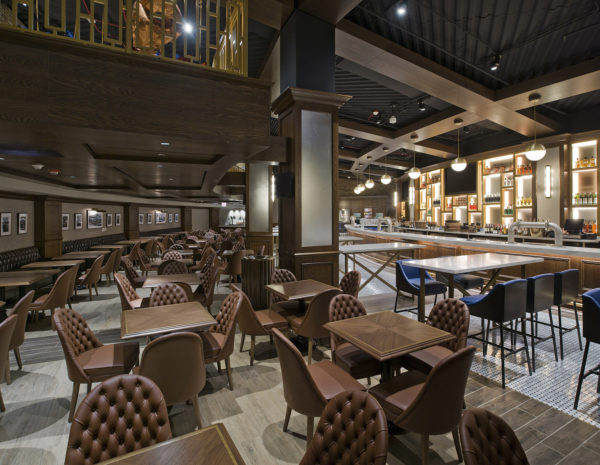
Image courtesy of Populous
“We were creating connections between Wrigley Field’s Chicago brand and references to Chicago within the American Airlines brand,” Holton says. To continue the theme, the space includes merchandise specific to the club with Cubs logos used in 1914.
Everything ties back to that era. Fans can use lockers within the space to store personal belongings and the locker’s key has a branded brass luggage tag to match the aesthetic of the signage in the space and tie back to the American Airlines brand. “Everything was designed to that level of detail,” she says.
A new club for 2019 on the upper level, and one of the final projects in the Wrigley Field renovations, the Catalina Club connects to the former spring training home of the Cubs in Catalina Island, California. Players used to take a boat to the island displaying the famed Chicago “W” flag. That unique nautical story carries through the club, with photos of players with palm trees and Chicago’s nautical history playing throughout the space. The design uses everything from images to decorative tiles to architectural styling. “One of the values of working on a brand team within an architecture firm is we are an integrated part of that team and we are all working toward the same vision,” Holton says. “We can make that vision come to life.”
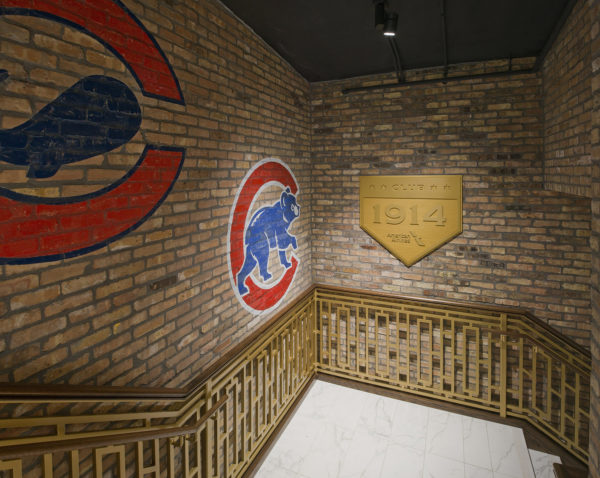
Image courtesy of Populous
A Baseball Balancing Act
Holton says that with a project like Wrigley Field, it was a puzzle to strike the right balance between the brand identity of Wrigley Field—seen in the signage and wayfinding—and that of the Cubs, which comes together through the pageantry of the murals and fan experience activations. Then comes the third layer: sponsors. “We are always striving to find authentic ways to integrate sponsors into the stories,” she says. “An authentic incorporation of a brand into a fan experience is critical in creating an authentic experience versus just incorporating a sign with a logo. We want to take it further than that and find storylines to find deeper connections.”
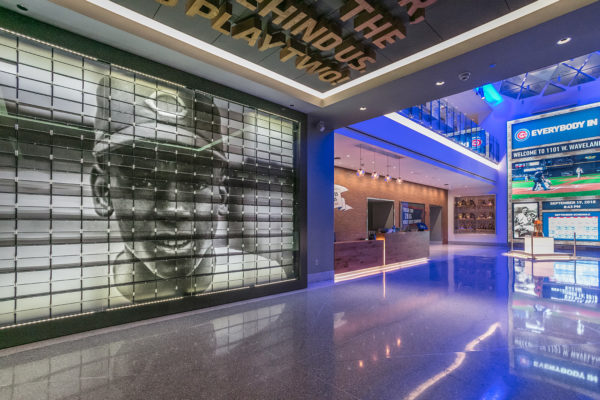
Image courtesy of Populous
Designing within a stadium—with its multiple layers and varied spaces—has gotten increasingly exciting over the years, Holton says. “Every project needs to set a new bar and crate that new fan experience,” she says. “We get to push boundaries and think in innovative ways because our clients are trying to reach new audiences and push further.”
And in the case of the Wrigley Field renovations, that push incorporates plenty of history with a healthy dose of pageantry.
Tim Newcomb covers sports design for HOW Design. Follow him on Twitter at @tdnewcomb.






